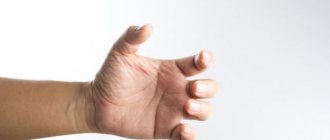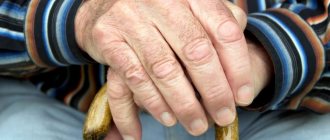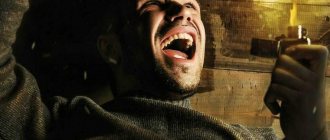Hemophobia is the fear of the sight of blood. This concept was first officially formulated by George Weinberg, a professor and psychiatrist in the USA. The name is associated with two terms - “hemo” - belonging to the blood, “phobos” - fear.
The main symptoms are:
- phobia when donating or transfusion;
- panic at the sight of wounds and scratches;
- fear of seeing violent scenes, images and films.
Phobic disorders put people, at the sight of red liquid, into a depressive state that brings hellish torment. A small drop of blood can make a person take involuntary postures and put him into a stupor. The disease is inexplicable and not understood, since there are no real reasons for its occurrence.
According to experts, blood phobia cannot be controlled and cannot be overcome due to weak willpower. Panic attacks involve reckless and stupid behavior. The patient, having reached a satisfactory state, cannot explain his behavior.
Hemophobia makes life difficult for a person and deprives him of medical procedures, such as blood transfusions, injections, surgical interventions, and going to the traumatology department. Fear constrains, and the patient does not promptly go to a medical institution for routine medical care. His inner world is filled with fear.
Causes of fear of blood
The onset of symptoms is noted in childhood. It appears much less frequently in adults. Since genetic predisposition has not been confirmed, there is an opinion that fear is transmitted from parents. This is due to the fact that they adopt the habits of adults.
Causes:
- traumatic event;
- unsuccessful surgery;
- death of a loved one;
- information from the media from the crime scene.
Overly impressionable people can become victims. One drop leads to associations of crime, death or cruelty.
The procedure for donating blood and treating a wound are postponed in some cases, as the doctor evaluates the harm and benefits in case of fear of hemophobia. One of the significant reasons for the emergence of a fear of blood is increased attention to negative experiences. “I’m afraid to donate blood from a vein” is a common phrase from patients. A person is constantly in anticipation of “bad things”, or is looking for non-existent illnesses in himself.
According to psychiatrists, the increase in the number of cases occurs during the period when abundant scenes of violence appeared on television. An anancaste person has her own opinion that an accident can happen to a person at any moment, and he bleeds to death.
Overcoming your fear, and, therefore, stopping being afraid of blood is the best medicine in treating the disease.
The reason for the development of hemophobia
The root of the fear of the sight of blood lies deep in the human psyche.
Therefore, no amount of persuasion to stop being afraid helps. In order to change a condition, you need to understand the reasons for its occurrence. The training “System-vector psychology” by Yuri Burlan reveals the unconscious mechanisms of our psyche. With its help, you can look into the darkest corners of the soul to understand where our fears and obsessive thoughts come from. People with phobias have a lot in common. These are emotional people who often have wet eyes. They are sensitive to beauty and aesthetics. They love cinema, theater, art. They try to avoid sad emotions that lead to strong feelings, for example, films about war. People who have a visual vector are capable of a wide range of emotions: from worrying about themselves to deep and sincere love and care for others.
The very first, basic emotion that has developed evolutionarily in people with a visual vector is the fear of death. The root of all phobias is fear for your life. That's why the sight of blood makes me feel so bad. After all, this is the main reason for the interruption of life: death from wounds, bites, and so on. This is an anchor that subconsciously causes panic fear and all subsequent symptoms. Ignorance of the laws of the psyche does not exempt one from the consequences.
How to overcome the fear of blood
The main methods of treatment include various breathing techniques, immersion in your fear, and living it. Having an idea of the innate mental properties and unconscious mechanisms of influence on a person, one can understand why this does not work.
The main reason for the manifestation of fear in visual people is strong concentration on oneself. Therefore, such methods are ineffective. They concentrate a person on emotions, forcing them to focus even more on themselves. To remove fears from your life, you need to understand how to implement the visual vector. How to go from horrifying fear for your life to developing a sense of compassion for another.
Answers can be obtained at the training “System-vector psychology” by Yuri Burlan. These are not empty words, but supported by the results of people who were able to assess the quality of life without phobias.
“Firstly, at one moment I realized that all my fears and anxieties, which had tormented me for a very long time, were gone. There were often worries and panics out of the blue without objective reasons, and uncertainty about the future. All this disappeared without a trace and has not returned to me for the last 2.5 years. Fears have generally become a funny phenomenon. Now I don’t understand how it is possible to experience fears? No, well, of course I did not become a fearless hero who at any moment is ready to leave the trench with his bare chest and throw himself at a machine gun, no, of course. But all the irrational fears that interfere with life have gone away, for example: fear of the dark, fear of enclosed spaces, fear of insects and animals, and all the other thousand phobias. Previously, as a child, I was very afraid of horror films, I even saw some red eyes of the terminator in the dark. Until the training, I was very scared by horror films. Now it’s even somehow funny to watch them, when next to you you see a visual girl, how she sways on her fears while watching horror films, but somehow it doesn’t affect you at all. I was afraid of the sight of blood as a child, sometimes I could faint during blood tests. Today I donate blood rather indifferently.”
“It turns out that fears and anxiety “live in the throat.” And when they leave, it becomes easier to breathe. For years I suffered from causeless anxiety, which often fell upon me. Psychologists helped me, but it was as if one hundredth part went away, and then the fears came again. My rational mind gave a logical explanation for half of my fears. But what good are these explanations if there is no normal life. And causeless anxiety in the evenings. By the middle of the course, I began to notice that I began to breathe freely. The clamps are gone. And by the end of the course, I suddenly suddenly noticed that anxiety and fears had left me. No, it happens, of course, that these states come back again, but somehow easily and superficially. And even bewilderment arises, why am I afraid of anything at all.” Diana Nurgalieva
Do not put off until later a life without fears and worries. Come for your results, let your days be filled only with joyful memories. You can sign up for the training here!
Manifestations of hemophobia in humans
Fear of blood is expressed in varying degrees. Mild forms bring less fear. As for serious medical interventions, they are carried out under the strict supervision of a doctor. In some cases, patients avoid visiting medical offices and hospitals. Because they have a fear of seeing blood or losing their own. A panic attack can begin even if the patient sees a small amount of red liquid.
Signs of an attack:
- pale skin;
- cardiopalmus;
- trembling of the arms and legs occurs;
- frequent and intermittent breathing;
- shortness of breath or suffocation;
- increased blood pressure.
Often attacks occur not so much from the sight, but from the thought and sensation of the smell of blood. Sweating, nausea and chills increase. A person cannot stand on his feet and needs a horizontal body position. The chest is filled with discomfort and compression. Often attacks are accompanied by loss of consciousness, uncontrolled behavior and unreasonable actions.
Additional Information! A person suffering from hemophobia will not be able to take adequate action in the event of an accident. He is unable to treat the wound or stop the bleeding, as he will become a victim of paralyzing fear.
Blisters, bruises, infections
Fear of needles has a large number of variations. For most people, anxiety occurs not at the moment of the injection, but while waiting for the injection in the doctor's office.
Urgency
Photo: TASS/Sergey Bobylev
Calming injection: why pensioners now need to get vaccinated
After the end of the summer season, a surge in incidence is expected
Many people are afraid of contracting dangerous infections and small air bubbles getting into the needle. Sometimes the very sight of needles and syringes is frightening, even if they are not intended for the patient, but are shown in films or photographs.
Some experience horror from the sensations when injecting the medicine - they literally feel how it spreads under the skin or muscles. Others fear that after the injection, bruises, bumps and long-term pain may appear.
It happens that the patient has suffered a negative personal experience - an unsuccessful injection, complications, rudeness of the medical staff. In this case, the image of a syringe is directly associated with pain.
Izvestia’s interlocutor, who suffers from trypanophobia, spoke about his dislike of needles and syringes:
- I'm just disgusted. A small sharp metal penetrates a vein, into the body... I don’t know what this is connected with, as a child I was not afraid of needles. I didn’t even think about it until I was 20–25 years old. Fortunately, the phobia does not affect anything. If you need an injection or vaccine, of course, I will agree. I’ll close my eyes, turn away and extend my hand,” shared Vladimir N.
“The vaccine will protect against the northwestern strain”
Academician of the Russian Academy of Sciences Areg Totolyan - about the new Russian variant of coronavirus and population immunity
It is doubly difficult if a person also suffers from hemophobia - the fear of the sight of blood. For such people, the fight against syringes begins long before making an appointment with a doctor. Already in a specialist’s office, fear can become insurmountable. Patients begin to fidget, try to escape, become dizzy, and sometimes faint.
How to get rid of the fear of blood
Hemophobia is difficult to cure. Only a psychiatrist can provide effective treatment if the cause is a traumatic situation. The doctor reduces the level of its significance and develops the patient’s psychological stability.
There are 3 methods used to treat fear of blood:
- psychological;
- medicinal;
- independent.
If the issue of treating hemophobia is being decided, then it interferes with a healthy life and the situation is out of control. The best method of combating the disease is considered to be frequent contact with a frightening element. An example would be interns and first-year surgeons who, as a result of practical training, get used to the sight of blood and are not afraid of it. This is real practice that really works. But psychotherapeutic methods are more reliable.
Note! Before donating blood or other traumatic situations, the patient is recommended to inform the medical staff about his illness. They, in turn, will be able to provide timely help and psychological support. Since in an emergency situation the patient will not stop thinking about blood and will not be able to respond to words.
With the help of psychotherapy
An effective method in the fight against homophobia is CBT (cognitive behavioral therapy). The patient tunes in to a positive wave, under the guidance of a psychotherapist. Gradually develops and consolidates an attitude to overcome fear. The procedures include meditation and breathing exercises. They help the patient calm down before and after blood is taken.
Situational anxiety is relieved through relaxation. Resistance to a frightening object is developed through the use of special psychotherapeutic techniques. According to experts, this method activates the mechanism that is responsible for adaptation and causes addiction to the type of frightening factor, and blocks the feeling of fear. Psychoanalysis and hypnosis are also used.
Hypnosis can really help a patient develop adequate reactions to the sight of blood. The process is aimed at developing skills to manage emotions in a stressful situation. Hypnosuggestive treatment develops complete psychological stability. A person is not afraid of blood or its signs.
Hypnosis is considered the most effective treatment technique. Eliminates the causes and symptoms of fear. Numerous scientific researches and successes have been achieved with positive results thanks to hypnosis. Severe cases require medication intervention. The dosage is selected by the attending physician.
If you suffer from such an ailment as fear of blood, on our website you can answer for yourself the reasons for its occurrence. A home environment, silence and comfort contribute to a better disclosure of spiritual impulses to oneself. Virtual communication with professional psychologists will help you set priorities in life and it will become clear how to act in situations related to blood phobia.
Medication
Medicines begin to fight the disease if the disease progresses and becomes the development of other mental disorders.
In this case, the following is prescribed:
- antidepressants;
- tranquilizers;
- sedatives;
- sleeping pills.
Pharmaceutical drugs stabilize the psycho-emotional status and eliminate nervous tension. This treatment is carried out in short courses and is prescribed for severe sympathoadrenal crises.
Important!
You should not use or prescribe medications yourself. You should consult a doctor. Since all of the above drugs have contraindications.
On one's own
Often, patients are interested in how to stop being afraid of blood without drug intervention. In the treatment of hemophobia, self-medication is practiced. This method is meditation. A system of self-development and self-knowledge.
Has the following qualities:
- strengthens well-being;
- normalizes mental state;
- improves physical health.
A person conducting meditation sessions withdraws from the outside world for a while and concentrates his thinking on his problem. Most importantly, the patient will be able to do this himself. By repeating the same installation for several weeks, you can get rid of the problem. For example, a mantra with the words “I am not afraid of blood” will take root in the subconscious, and over time, healing will occur.
Phobias
Vomit
20667 01 November
IMPORTANT!
The information in this section cannot be used for self-diagnosis and self-treatment.
In case of pain or other exacerbation of the disease, diagnostic tests should be prescribed only by the attending physician. To make a diagnosis and properly prescribe treatment, you should contact your doctor. Phobias: causes, symptoms, diagnosis and treatment methods.
Definition
Phobias are an anxiety mental disorder in which a person is haunted by a constant feeling of unreasonable fear caused by certain types of objects, actions or circumstances. This is an absolutely irrational feeling, for which there is no basis, but at the same time all-encompassing and persistent. To date, more than 500 types of phobias have been described. The most common of these are social phobia and agoraphobia.
The vast majority of phobias are classified as mental disorders.
Translated from Greek, “phobia” means “fear, fear.” Natural fear protects a person in situations where he could be seriously harmed or even killed. Every healthy person experiences natural fear from time to time, which is a protective mechanism of the self-preservation instinct. This feeling of fear is completely conscious and controlled by common sense and logic. But when a person begins to fear something that does not pose a real or even potential threat to him, we are already talking about a phobia.
People with phobias may be afraid of thunderstorms, blood, flying on airplanes, crossing the street, being in a confined space - things that most people are completely calm about. Sometimes they experience fear of completely harmless things, such as the dark, water, and even the starry sky.
A person prone to a phobia develops panic, and in the future he feels even greater fear of a repetition of a particular situation, trying to avoid circumstances and objects that cause panic horror.
Emotionally sensitive people with a rich imagination and/or a weak nervous system are prone to phobias. It has been established that for the most part, attacks of severe fear are provoked by one single case when a dangerous (or imaginary dangerous) situation has arisen. Having experienced it once, people try in every possible way to prevent it from happening again.
As a result of the cultivation of negative memories and images, a phobia develops.
Phobias, as a type of neurotic disorder, are a widespread phenomenon, occurring in 5-12% of the population. Most phobic disorders, except social phobias, are more common in women.
Causes of phobias
There are several groups of factors that can influence the development of phobias.
Genetic
. The influence of genetic factors averages 35-45%, and only for agoraphobia, which is the most inherited form of phobia, this figure increases to 61%.
Biochemical
. In some cases, patients with phobias showed increased concentrations of inflammatory markers, including cytokines and C-reactive protein, which may be associated with an activation of the stress response of central and peripheral immune cells. Social anxiety is further characterized by neuroendocrine changes (increased cortisol levels and decreased testosterone). In addition, the use of psychoactive substances, alcohol and drugs can contribute to the development of pathological fears.
Psychological
. Tendency to experience negative emotions, fixation on negative events, childhood and adolescent psychological trauma. People with phobic disorders often experience timidity, excessive caution, increased impressionability, and indecisiveness even in childhood.
High levels of social anxiety are associated with lack of social skills and negative self-esteem.
Classification of the disease
According to the International Statistical Classification of Diseases and Related Health Problems, anxiety-phobic disorders are coded F40 (F40.00 without panic disorder, F40.01 with panic disorder).
Phobias that doctors encounter include:
- Agoraphobia is the fear of any situations from which there is no immediate way to get out and return to a safe place. And also the fear that timely help will not be available. This type of phobia manifests itself in fear of crowds, public places, unaccompanied travel, and movement outside the home.
- Social phobias are a pronounced fear of being the center of attention of strangers. Characteristic of those who experience anxiety about how they appear in the eyes of others. A person worries that the words he speaks will sound stupid and inappropriate, that his appearance is repulsive, and that no one needs him. This type of phobia manifests itself in a wide variety of everyday situations.
- Specific (simple or isolated) phobias are all other phobias that represent fear and anxiety about a specific situation or object. A huge number of phobias have been described, the names of which, as a rule, are formed using the roots of Greek words that denote the object of fear. The most famous and common are:
- nosophobia - fear of getting a serious illness: cardiophobia, cancerophobia, etc.;
- zoophobia – a pathological fear of certain types of animals, for example, snakes, spiders, rats or dogs;
- fear of natural phenomena (for example, hurricanes, heavy rains);
- fear of blood, injections, injuries (eg, needles, medical procedures);
- fear of situations, including:
- claustrophobia - fear of closed spaces;
- phagophobia - fear of choking on food;
- gypsophobia - fear of heights;
- oxyphobia - fear of sharp objects;
- Aerophobia - fear of flying in aircraft.
Symptoms of phobias
The main symptom of a phobia attack is the sudden onset of extreme anxiety, which very quickly takes the form of panic fear.
Common symptoms for all types of phobias are:
- Autonomic symptoms:
- strong and rapid heartbeat;
- sweating;
- shaking or tremor;
- dry mouth (but not due to medications or dehydration).
- difficulty breathing;
- feeling of suffocation;
- chest discomfort or pain.
- dizziness, fainting;
- a feeling of unreality of surrounding objects (derealization);
- fear of loss of control over the situation and insanity;
- fear of dying.
- hot flashes or chills;
- numbness or tingling sensation in the extremities.
Social phobias additionally cause the following symptoms:
- skin redness;
- fear of vomiting;
- urge or fear of urination/defecation.
If a person notices two or more of the following symptoms in himself or his loved ones, there is a need to seek specialized help:
- unexplained strong fear, panic, anxiety for six months;
- the realization that such strong fear has no real reason;
- purposeful avoidance of places, situations, objects, objects due to severe fear;
- avoidance brings discomfort into daily life and interferes with normal functioning.
The causelessness and groundlessness of fear only increases the level of anxiety.
Diagnosis of phobias
At the initial examination, the doctor carefully collects a life history and listens carefully to the patient, conducts a physical examination (external examination, measurement of height, body weight, assesses the level of physical development, integrity of the patient’s skin) in order to determine the somatic status. To make a reliable diagnosis, the patient's condition must not be explained by other disorders. Otherwise, additional examination is necessary.
Diagnosis of phobias requires confidential contact between the psychotherapist and the patient.
During the conversation, the specialist asks leading questions taking into account what the patient is telling. During such communication, it is possible to determine the presence of specific phobias, and sometimes the reason that provoked their appearance.
In his medical practice, each psychotherapist uses various clinical diagnostic scales and tests, with the help of which it is possible to distribute fears, identify the dominant ones among them, and establish the degree of fear and anxiety.
The main goal of laboratory and instrumental examinations is to exclude somatic diseases that may cause symptoms similar to those of an anxiety-phobic disorder. For this, the following studies are prescribed:
- general (clinical) blood test;
Causes and symptoms
Experts cannot name the only reason that causes phobias, but, as a rule, this is an echo of negative childhood experiences. However, an adult can also find himself in a situation that leaves a significant imprint on the psyche. Often people simply forget that bad things happened to them before, but for some adults they emerge in the subconscious - the connection between the incident and the emotions experienced is deposited in it.
There is an opinion that obsessive fear can be inherited and “triggered” after stress. A heightened instinct of self-preservation also contributes to the emergence of phobias.
As for the signs of this mental disorder, they are as follows:
1. The desire to avoid the situation causing the phobia by any means.
2. Feeling of a lump in the throat, inability to breathe.
3. The whole body is shaking.
4. Rapid heartbeat - the heart literally “breaks out” of the chest.
5. The appearance of sticky cold sweat.
6. Weakness in the body, it stops listening, immobilization.
7. Terrible fear.
8. The stomach hurts, there may be loose stools, vomiting.
Get closer to fear
For some trypanophobia sufferers, the most obvious way to cope with the problem is to avoid injections at all costs. According to a survey of Canadian researchers, 7% of parents and 8% of children said fear of needles was the main reason they delayed vaccination.
Urgency
Photo: RIA Novosti/Alexander Kryazhev
The surest way is to seek help from a psychologist. True, few dare to do this. For most people, the problem does not cause much discomfort—few people have to get injections every day.
— Although the phobia exists, patients practically do not seek treatment. In 25 years of practice, I have not had a single such case,” says psychiatrist Mikhail Tetyushkin. - If you still have anxiety, tranquilizers can help get rid of it. It is enough to take them an hour before vaccination. In my opinion, there is no need for antidepressants.
As part of vaccination: how the vaccination incentive program will work
After the first injection against COVID-19, pensioners in Moscow will receive a gift card for 1 thousand rubles or a promotional code
If we talk about the treatment of fear, then first the anxiety-phobic reaction is corrected, and then stabilizing (exposure) therapy is carried out, when the patient gradually gets closer to the source of his anxiety.
“First, the patient simply looks at the syringe, then over the course of one to two weeks he takes it in his hand for 10, 20, 30 seconds, and so on. Then he touches the body with the needle, without, of course, perforating the skin. And gradually the phobia may disappear,” said the psychiatrist.
What is the danger?
Like any other fear, hematophobia or hemophobia (both names are used) generally cannot harm a person who is afraid of the sight of blood.
But powerful fear manifests itself not only at the sight of one’s own bloody clothes or a drop of blood from a cut finger. Exactly the same panic grips a hemophobe when, for example, he witnesses another person being injured. In the second case, there are escape routes: run away or turn away, but you won’t be able to get away from your blood, so the experience will be brighter, stronger and more painful. Doctors have already had to deal with situations where they had to provide assistance not only to the victims, but also to random passers-by, among whom were hemophobes.
Hemophobia does not select its “victims” based on age or gender. The sight of blood can make children and adults, men and women, sick; fear does not depend on the state of health and well-being.
Anxious expectations
Already in the first wave of the pandemic in 2021, psychiatrists drew attention to changes in the mental health of the population. Lockdowns, other coronavirus restrictions, remote work, a person constantly being at home - all this has already provoked negative psychological effects. Add to this anxious expectations - fear of becoming seriously ill, fear for loved ones, the possibility of losing a job - and here it is, a set that places a heavy burden on the human psyche.
At the same time, some researchers have started talking about the increase in suicidal and depressive feelings among completely healthy citizens in different countries of the world. Moreover, data began to appear about increasing cases of domestic violence and divorce.
Photo © Pixabay
When a person gets sick, his anxious expectations intensify. The patient begins to monitor his condition, symptoms, temperature, and breathing with fear. No one wants to end up in a hospital under strict quarantine. Even more fears are caused by the possibility of developing severe complications, the use of ventilators and other procedures. Now doctors already know that the most severe psychological consequences occur precisely in patients who have undergone artificial ventilation.
"Side effect"
Another factor is the side effects of medications used to treat COVID-19. For example, glucocorticosteroids (GCS) are widely used in modern anti-Covid therapy. They are often prescribed in high doses and for a fairly long period. But at the same time, GCS can cause hallucinations, delusional states, depression and even manic-depressive states and paranoia. Taking other medications used in the treatment of Covid, for example, some antiviral drugs, also has a negative impact on the psyche.











